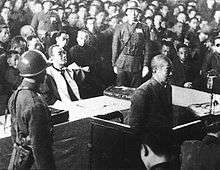Hisao Tani
| Lieutenant General Tani Hisao | |
|---|---|
 Lieutenant General Tani Hisao | |
| Nickname(s) | Tiger of Kyushu |
| Born |
22 December 1882 Okayama, Japan |
| Died |
26 April 1947 (aged 64) Nanjing, China |
| Allegiance | Empire of Japan |
| Service/ |
|
| Years of service | 1903–1945 |
| Rank | Lieutenant General |
| Commands held | Imperial Japanese Army |
| Battles/wars | Russo-Japanese War, Second Sino-Japanese War, Pacific War |
Hisao Tani (谷 寿夫 Tani Hisao, 22 December 1882 – 26 April 1947) was a Lieutenant General in the Imperial Japanese Army in the Second Sino-Japanese War, and was implicated in the Nanjing Massacre.
Biography
Tani, a native of Okayama Prefecture, graduated from the 15th class of the Imperial Japanese Army Academy in 1903, and from the 24th class of the Army War College. He saw service as a second lieutenant in the Imperial Guard's infantry regiment during the Russo–Japanese War. Subsequently, he was posted to Great Britain as a military attaché from 1915–18, during which time he was an official observer for the Japanese government on the combat situation on the Western Front in World War I. After his return to Japan, from 1922–24, he was attached to 6th Regiment/IJA 3rd Division.[1]
In 1924, he became an instructor at the Army War College, and his texts on strategy and tactics during the Russo–Japanese War became required reading. From 1929–32, Tani was assigned to various posts in the Imperial Japanese Army General Staff, and in 1932 he was made Chairman of Military Investigation. In 1933 he took command of the 2nd Imperial Guards Brigade; in 1934, command of the Tokyo Bay Fortress, and in 1935 command of the 9th Depot Division.
From 1935–37, he served as commanding officer of the 6th Division (Imperial Japanese Army), which was assigned to the China Expeditionary Army in December 1937 under the overall command of General Matsui Iwane. The 6th Division fought in North China during the Peiking – Hankow Railway Operation. Shipped south with the Japanese 10th Army, it took part in the end of the Battle of Shanghai, and the Battle of Nanking.
Returning to Japan at the end of 1937, Tani became Commander in Chief of the Central Defence Army until 1939 when he went into reserve and retired. In 1945, towards the end of World War II, Tani was recalled to active service and given command of the IJA 59th Army and Chugoku Army District.
Trial and Execution


After the end of World War II, the Chinese government demanded that Tani be extradited to China to stand trial for war crimes at the Nanjing War Crimes Tribunal. Tani denied all charges, blaming Korean soldiers for the massacre.
Hundreds of survivors as well as several foreigners who witnessed the atrocity from Nanking Safety Zone, including Miner Searle Bates from the University of Nanking, testified against Tani. He was found guilty of instigating, inspiring and encouraging the men under his command to stage general massacres of prisoners of war and non-combatants and to perpetrate such crimes as rape, plunder and wanton destruction of property, during the Battle of Shanghai, the Battle of Nanking and early in its occupation, the Rape of Nanking, and he was consequently executed on 26 April 1947.[2]
References
- Dorn, Frank (1974). The Sino-Japanese War, 1937–41: From Marco Polo Bridge to Pearl Harbor. MacMillan. ISBN 0-02-532200-1.
- Hsu Long-hsuen & Chang Ming-kai, History of The Sino-Japanese War (1937-1945), 2nd edition (1971); translated by Wen Ha-hsiung, Chung Wu Publishing (address #33 140th Lane, Tung-hwa Street, Taipei, Taiwan)
- Higashinakano, Shūdō. The Nanking Massacre: Fact Versus Fiction (2005), Sekai Shuppan, Inc.; ISBN 4-916079-12-4/ ISBN 4-916079-13-2 (original Japanese edition: Nankin gyakusatsu no tettei kensho (1998), Tendensha, ISBN 4-88656-153-5; C0021)
- Yoshida Hiroshi Tennou no guntai to Nankin jiken, 1998, Aoki shoten; ISBN 4-250-98019-7.
| Wikimedia Commons has media related to Hisao Tani. |
Notes
- ↑ Ammenthorp, Steen. "Tani, Hisao". The Generals of World War II.
- ↑ "The veteran who drove Hisao Tani to the execution ground", chinadaily.com.cn, 3 August 2015; accessed 8 March 2016.